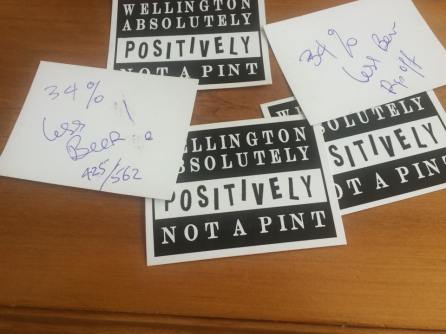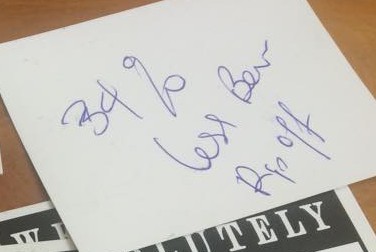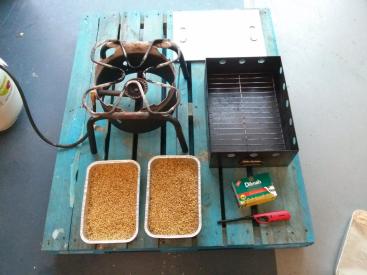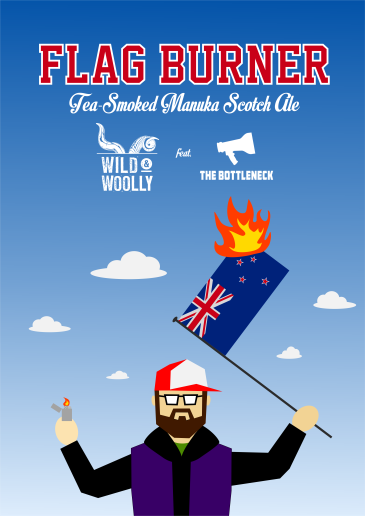Who went to Beervana this year? Did you all have as excellent a time as I did? Were all the the beers you tried absolute blinders? Did you feel that the vibe was on point and the effort from the vendors top notch? Were you stoked that the southerly wasn’t blowing, so the stadium was actually at a temperature humans could inhabit? Good on the organisers for sorting that one out.
In all seriousness, I was very impressed with Beervana this year and I’m stoked to see what next year will bring. Well done to Sarah Miekle, The Wellington Culinary Events Trust, Beth Brash, the breweries, restaurants, and of course everyone else who contributed in in any way, shape or form.
I had a great time, and so to did a lot of visitors to this city – Wellington was chock full of Aussies, Brits, Americans and of course, New Zealanders from every corner of the country. And here lies the only tiny little blotch on the whole event. A small group of people; I don’t know who or from where (and I really don’t care) came into town, visited various bars and left behind these little cards:
 As you can see, the accusation here is that the bars, which offer a serving of beer smaller than 562 ml are ripping off customers.
As you can see, the accusation here is that the bars, which offer a serving of beer smaller than 562 ml are ripping off customers.
 These are pretty serious claims, which I like to repudiate. Before I begin, I must point out, none of these cards were left at Golding’s. They were however, left at Hashigo Zake, Malthouse, Bethel Woods and Little Beer Quarter. As such, the views I’m going to put out in this post are entirely my own and do not represent those of my employer.
These are pretty serious claims, which I like to repudiate. Before I begin, I must point out, none of these cards were left at Golding’s. They were however, left at Hashigo Zake, Malthouse, Bethel Woods and Little Beer Quarter. As such, the views I’m going to put out in this post are entirely my own and do not represent those of my employer.
At the same time, I feel it is appropriate for me to comment because Golding’s uses the same pricing formula (give or take) as all these other bars. I am the person who sets the prices of different products at the bar. By extension then, these people are accusing me, personally, of ripping off our punters. I take exception to that.
What You Got Right:
Yes, you are correct. 425 ml does not fit any official definition of a ‘pint’. There are several different definitions of a ‘pint’, which vary depending on where you are in the world and what you’re measuring. When it comes to beer, a ‘pint’ is technically either 568 ml (strangely, not the 562 ml mentioned on the card) or 473 ml (which, for the record is what Hashigo uses).
So technically, you are correct. Bully for you. But you’re also wrong: since we adopted the metric system in 1976, the definition of a ‘pint’ ceased to have any legal relevance. In the same way that I can’t sell you a ‘pound’ of butter or a ‘gallon’ of petrol, without telling you the relevant mass in grams or volume in litres, technically I can no longer sell you one ‘pint’. I have to sell you X number of millilitres.
But that’s not quite how modern language works and people still order ‘pints’ in bars. The difference is that now the common usage in New Zealand is that ‘pint’ means “the largest single-serving of beer you offer”. You may not like this usage. You can protest it until you’re blue in the face. But you won’t be able to change the way people use the term.
So congratulations, this make you the beer equivalent of King Canute, telling the tide to turn back. It ain’t gonna happen.
What You Got Wrong
Everything else. But let’s start with the assertion that you have been served “34% less beer for the same $”. This is utterly false.
Let’s have a quick talk about the price of beer. Basically, I’m going to give you two links: Stu’s breakdown of the cost of a Yeastie Boys Beer. Also useful is Dom Kelly’s breakdown of the pricing of different beers from Australia, New Zealand and the United States.
Basically, beers are priced according to margin. Breweries set the price of the keg, then we put on a retailer margin (~22%), and then GST on top of that. Now of that margin, it breaks down in various ways. The biggest cost that needs to cover is price of the beer. After that come staff wages, and following that, various other expenses, ranging from rent, to electricity, to freight on empty kegs, to sanitising solution for our dishwasher, to cloths for drying glasses, to food grade carbon dioxide bottles to push the beer through our taps and a million other things.
After all of these is profit. Now we are profitable. We need to be. We’re a business, and this is capitalism. You’ll have to take my word for it, but let me assure you, neither Golding’s, nor any other beer bar in Wellington will ever make its owners fabulously wealthy. I will never be a millionaire from working my job. Hell, I’ll probably never be able to own a house.
What I’m really getting at here though, is that beer prices work on a set margin, and this is calculated by the millilitre. So your assertion that you should get more beer for the same price is ludicrous. Working off a margin, if you wanted 568 ml of a beer that costs $10 for 425 ml, you would need to pay $13. If it was a more expensive beer, say a big Imported IPA that cost $12.5 a 425 ml, you’d be paying around $17 an imperial ‘pint’.
Now I’m perfectly willing to do that for you. Come in, tell me who you are, tell me you want an imperial ‘pint’, and I will make a product item in our till system just for you. But you better be willing to pay, because if you think you should be getting a 568 ml serving for the same price as 425 ml, then you are delusional. That’s not how mathematics work.
“But Dylan,” I hear you say, “In XYZ town/city, I can get an imperial ‘pint’ of the same beer for less than $13”. Yes, this is true; I quite enjoy going to Nelson or Christchurch and paying slightly less for beer. The reason for this is because of variation in local economies. Just like the cost of rent changes from city to city – renting a two bedroom house in central Wellington or Auckland will cost you much more than a similar house in Hamilton – the cost of beer will vary from place to place (in fact rent is one of the big factors).
If you’d like a more dramatic illustration of this, then all you need to do is step over the Tasman. I’ve met Australians who have been astounded that they can get a Coopers for the same price (or even cheaper) in New Zealand than they can at home. On the other hand, in parts of America you can pick up a ‘pint’ (of the 473 ml type) for the equivalent of $4-6, plus tax and tip.
But the most extreme example I’ve personally come across is Norway. In Oslo I paid the equivalent of $18 for what amounted to 300 ml of 7% beer (I was almost never served a ‘pint’ in Scandinavia). And you know what? I didn’t feel the need to complain. Because that’s how the world works. If I can’t deal with that fact, that’s my problem, not the operators of the Norwegian bars and restaurants I visited.
If you really can’t enjoy a beer because because it came in the wrong glass size, for slightly more than you might pay elsewhere, then I don’t think you’re a good Beer Geek. In my books you’re a pain in the arse with entitlement issues. But enough of this. Let’s get down to the nitty-gritty.
Why I’m So Angry
This really boils down to two things. First of all, the way the message was delivered. Note cards? Dropped on the table as you scarpered? What are you? An emo 16 year old? A passive aggressive flatmate, leaving notes for everyone around the house before locking themselves in their room?
That’s not how adults should behave. If you have criticism for someone, you discuss it privately, in person or via message. Or, you could face up to your peers and state it in a public forum. God knows I spend a decent part of this blog criticising people in the beer industry, but I sign my name to it. On the left hand side of this page is a link to my Twitter, where anyone can contact me.
Dropping an anonymous note is cowardly. But even this isn’t what annoys me the most. What really gets me going is the accusation that I, or any of my fellow Bartenders/Owners/Managers are deliberately, maliciously, ripping people off.
I am an honest human being. If nothing else, let that be the last thing they say about me. When I’m gone, put that on my gravestone. You’re accusing us of setting out to swindle. I wouldn’t do that to a stranger, and our customers aren’t strangers to us. They’re our friends. You think we’re being greedy when we set our prices? I assure you we’re not. I spend a big chunk of my week buried in the company accounts. I know the numbers inside-out.
Yes, we make money. We’re businesses, not charities. We need to make money if we’re to survive. Because this is our livelihood. Each bar has at least half-to-a-dozen employees who also rely on their jobs to live. And it’s not just us. It’s the whole damn industry – the distributors, the logistics companies, the brewers, the hop and malt growers, the brewery equipment manufacturers and thousands of other invisible people cash their paychecks when you buy a beer. To be sustainable everyone down the line needs to make money, or the whole thing doesn’t work.
But if you honestly think that the markup is too much, feel free to open your own bar in Wellington. Charge what you think it should cost. Put us all out of business even. Be our guest.
Мы вас похороним.





